Abstract
Increase of plastics accumulation in the environment cause ecological threats and has been one of the serious issue worldwide. In the current study, two bacterial isolated strains Bacillus safensis and Bacillus amyloliquefaciens were used for their plastic degradation capabilities. The biodegradation of low density polyethylene thermoplastic was assessed by weight reduction, Scanning electron microscopy (SEM) analysis and by culture media pH alteration. The results shows that Bacillus safensis was more efficient and degrade 18.6% LDPE than Bacillus amyloliquefaciens that degrade 18% of LDPE after incubation period of 30 days. Moreover, it was also noted that longer incubation periods results in higher biodegradation of low density polyethylene thermoplastic. It is concluded that the biodegrading ability of Bacillus safensis is more than Bacillus amyloliquefaciens as confirm from weight reduction of low density polyethylene thermoplastic.
License
This is an open access article distributed under the Creative Commons Attribution License which permits unrestricted use, distribution, and reproduction in any medium, provided the original work is properly cited.
Article Type: Research Article
EUR J ENV PUBLIC HLT, Volume 5, Issue 2, 2021, Article No: em0069
https://doi.org/10.21601/ejeph/9370
Publication date: 04 Jan 2021
Article Views: 4318
Article Downloads: 3497
Open Access References How to cite this article
 Full Text (PDF)
Full Text (PDF)